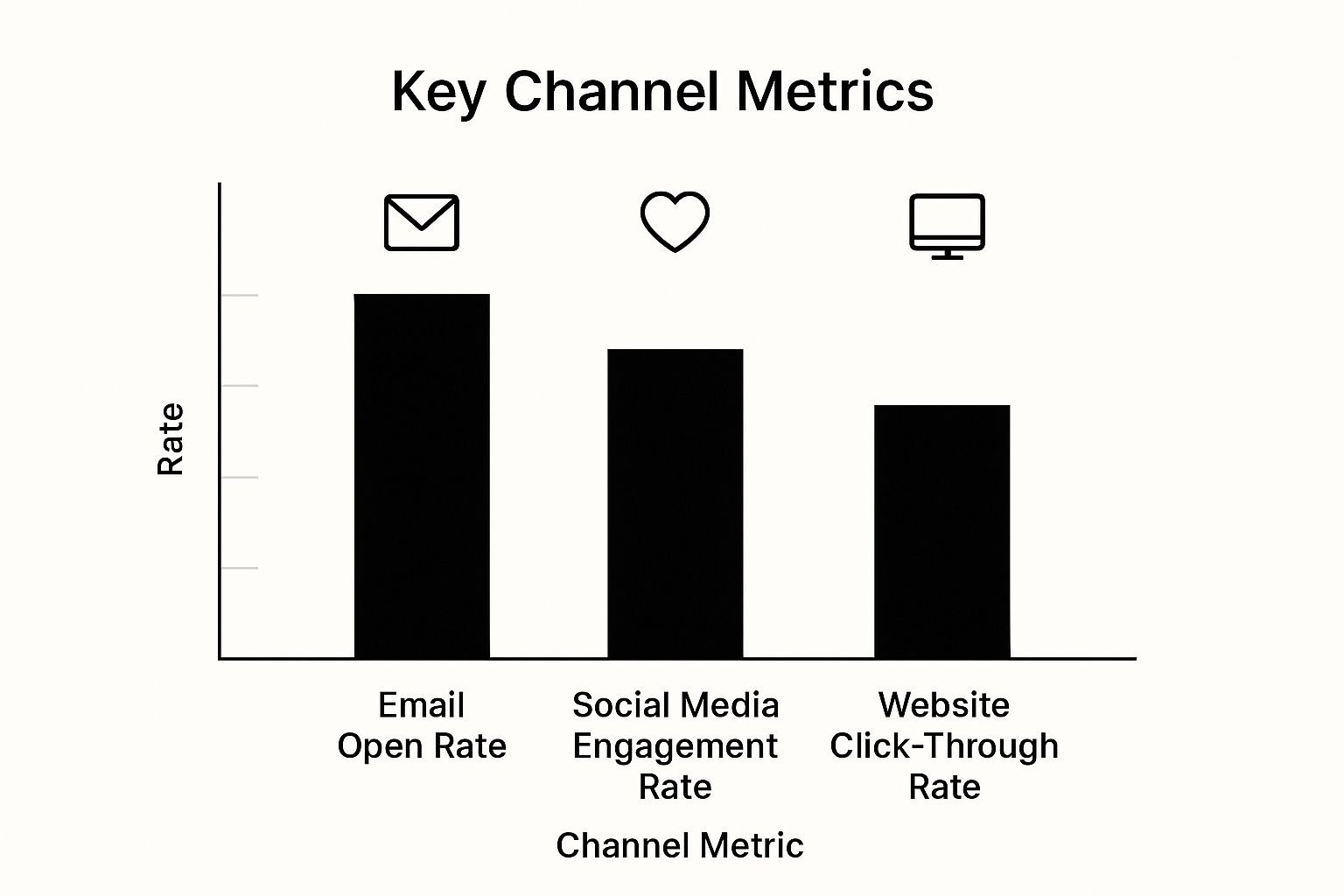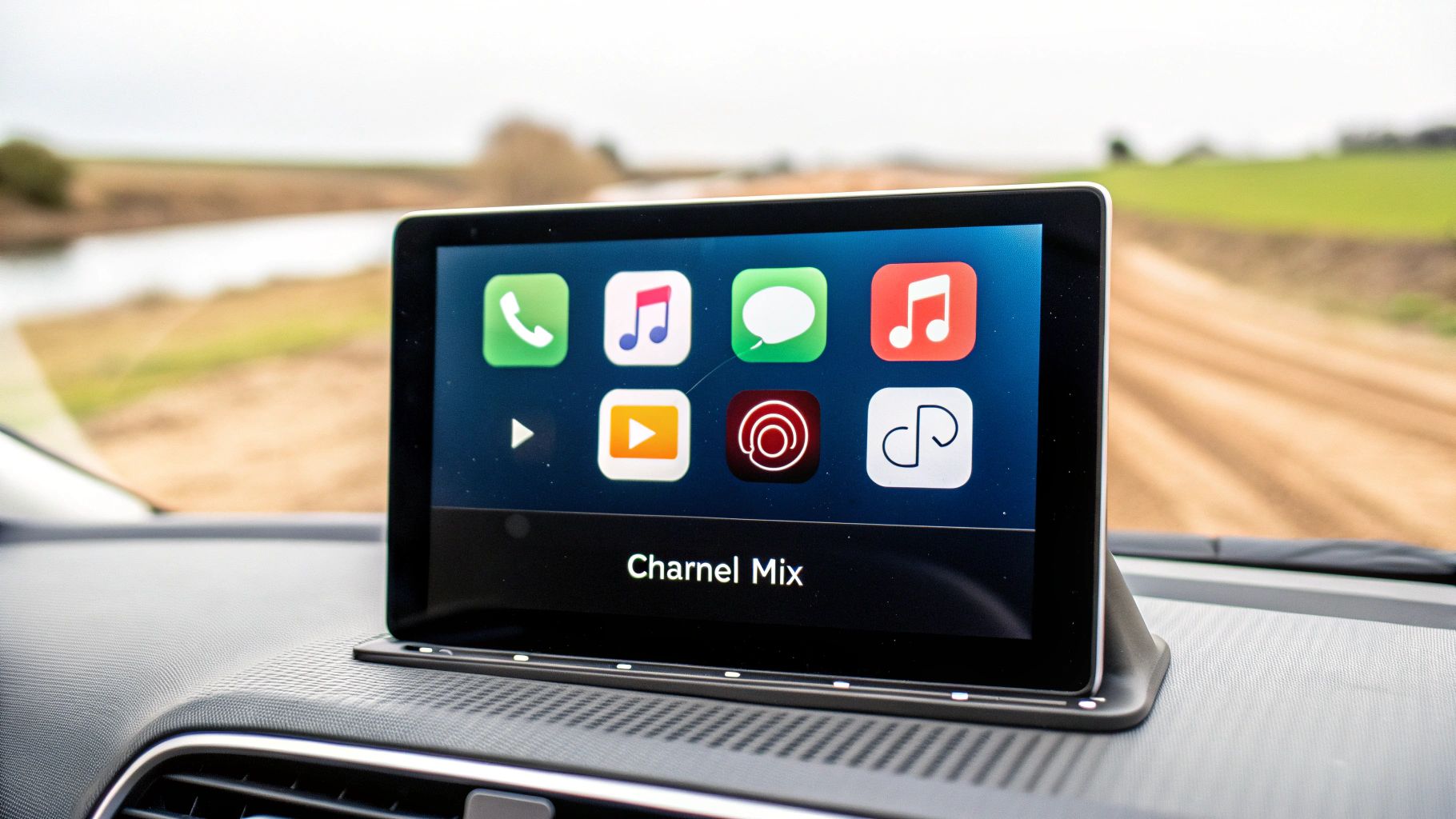A multichannel communication strategy is all about using multiple platforms—think email, SMS, and social media—to connect with your customers. The goal is simple: be where your audience is. You're giving them different ways to reach you on the channels they already use and love.
Let's be real. Relying on a single communication channel today is like trying to run a shop that's only open for one hour a day. You’re leaving a ton of opportunity on the table.
Modern customers expect to engage with businesses on their own terms, and that means being able to switch from email to a phone call to social media without a second thought. A solid multichannel communication strategy isn't just a "nice-to-have" anymore; it's essential for any business that wants to grow and build real customer loyalty.
This whole approach taps into a major shift in how people behave. We don't just stick to one platform. We move between them all day long. Getting a handle on mastering your multichannel marketing strategy is a great starting point to see how all these pieces should fit together.
The numbers don't lie: more channels bring bigger results. Brands that use three or more channels in their communication strategy see an incredible 287% higher purchase rate compared to those sticking to just one.
Why? Because consistent, repeated exposure across different platforms keeps your brand front and center in your customers' minds.
But there’s an important distinction to make here. While a multichannel approach gets you in front of people, the channels often work in silos. That's where the idea of an omnichannel strategy comes in. Omnichannel takes it a step further by creating a single, connected conversation that follows the customer no matter how they contact you.
To quickly see the difference, here's a simple breakdown:
While both are powerful, understanding whether you're aiming for broad presence (multichannel) or a deeply integrated experience (omnichannel) will shape your entire approach.
To really nail your strategy, you have to know how each channel is pulling its weight. Are your emails getting opened? Are your social posts driving action?
The image below gives you a snapshot of how different channels can perform.

As you can see, email might have a great open rate, but social media could be your winner for direct engagement. This is exactly why a balanced, data-informed approach is so critical. By seeing these differences, you can start making smarter decisions about where to invest your time and energy.
If you're ready to build a plan that truly connects with your audience, check out our guide and master your multi-channel communication strategy today.

A powerful multichannel communication strategy doesn't start with buying new software. It begins with a deep, almost obsessive, understanding of the people you serve. Before you can even think about which channels to use, you have to map out the entire journey your customers take with your business.
This means looking at every single interaction point, or touchpoint, from the first time they hear about you to long after they've become a loyal client. Think about it. A new customer might see a social media ad, call for more information, get an appointment reminder via SMS, and then receive a follow-up survey by email. Each step is a crucial part of their experience.
Your goal here is to pinpoint these touchpoints and figure out which channels your customers genuinely prefer for each specific interaction. Guessing leads to wasted effort and missed connections, but solid data gives you a clear path forward.
First things first: take stock of what you're already doing. Don't just list your channels—dig into their performance. Look at your website analytics, check your email open rates, and see what's happening with your social media engagement. This initial audit creates a baseline so you know what's working and, just as importantly, what isn't.
Gathering direct feedback is just as critical. You can do this without a huge budget or complicated tools.
This isn't just busywork. This data is the foundation of an effective strategy. It helps you move from making assumptions to making informed decisions, ensuring you meet customers exactly where they are.
As you map out your customer's communication journey, remember the broader goal is building seamless omnichannel customer journeys for a truly unified and impressive experience.
With this data in hand, you can start building detailed customer personas. A persona is a fictional character that represents a key segment of your audience. It goes way beyond basic demographics to include their real-world communication habits and preferences.
For example, a persona for "Service-Seeking Sarah" might look something like this:
This level of detail is what makes your multichannel strategy truly actionable. It tells you exactly when to use your AI receptionist for calls or when to fire off an automated text for reminders. You can see how AI self-service portals and multichannel integration work to connect these different touchpoints smoothly.
By mapping the journey and creating clear personas, you can be confident that every single message you send is hitting the right channel at the perfect time.

If that chart tells us anything, it’s that customers want to connect on their own terms. A multichannel approach isn't just a nice-to-have anymore; it's essential. This is where we move from theory to practice, and frankly, where things get exciting. Putting tools like an AI receptionist and an outbound dialer into your workflow is how you actually manage all these channels without burning out your team.
This isn't just about slapping some automation on top of your current process. It’s about building a smarter, more responsive system where AI handles the repetitive, predictable stuff, freeing up your people for the conversations that truly matter.
First things first, let's get your inbound channels sorted. An AI receptionist can completely change the game for your phone and SMS communications, turning a potential bottleneck into a lead-capturing machine that runs 24/7.
Think of it as your most reliable employee—one who never sleeps, calls in sick, or misses a call. You can train it to answer common questions, route the tricky calls to the right human, and even book appointments directly into your calendar.
Here's how this plays out in the real world:Imagine a local plumbing company. A customer calls at 10 PM with a leaky faucet. The AI receptionist answers instantly. It asks a few clarifying questions, schedules a visit for the next morning, and fires off an SMS confirmation. No human intervention needed. The job is booked, and the lead is secured while everyone else is asleep. For any service business that depends on a quick response, this is a total game-changer. We've got more examples in our guide on how AI assistants improve multichannel communication.
Now, let's flip the script and talk about proactive communication. An AI-powered outbound dialer lets you reach out to customers without the soul-crushing, manual work of dialing number after number. This is perfect for valuable, non-intrusive contacts.
You could use it for things like:
The key here is to add value, not be an annoyance. Your outbound AI needs a clear, helpful purpose for every call—like confirming details or gathering feedback. This actually strengthens the customer relationship instead of damaging it.
The market for this tech is exploding for a reason. The global multi-channel marketing hubs market was valued at USD 6 billion in 2024 and is expected to grow at a 17.7% CAGR through 2034. This surge is fueled by the need for tools that can pull customer data from everywhere and use AI to create hyper-personalized interactions, turning a basic communication strategy into a powerful engagement engine.
When you pair an inbound AI receptionist with an outbound dialer, you create a complete communication loop. The receptionist captures and qualifies leads, and the dialer follows up to ensure they're happy and encourage them to come back. And as you build out your tech stack, checking out top AI content creation tools can also boost your efficiency across all these channels. You end up with an integrated system where AI does the heavy lifting, making your business more responsive, efficient, and focused on what really counts: the customer.
When you're juggling phone calls, emails, and text messages, it's incredibly easy for the customer's experience to feel disjointed and confusing. The whole point of a solid multichannel communication strategy is to make sure that no matter how someone reaches out, it feels like one continuous conversation with your brand.
This kind of consistency doesn't just happen. It takes a real plan to keep your brand voice unified and to make every single interaction feel personal. If you drop the ball here, you risk sending mixed signals or, even worse, forcing customers to repeat themselves—a surefire way to send them running. The goal is to make every touchpoint feel connected and familiar.
This is where a central messaging guide becomes your playbook. Think of it as more than just a style guide with logos and colors; it's the script for your tone, your phrasing, and the core messages you want to get across on every platform.
Your messaging guide should be the single source of truth for anyone—and any AI—that talks to your customers. It’s what ensures your brand sounds like you, everywhere.
It needs to clearly lay out:
For instance, the script your AI receptionist uses for a missed call should have the same friendly-but-professional vibe as your email follow-ups. That kind of consistency builds trust and makes your brand feel much more reliable and human.
A brand that sounds the same on a phone call as it does in an email is a brand that feels trustworthy. Don't underestimate the power of a consistent voice—it's the glue that holds your multichannel experience together.
Consistency gets you in the door, but personalization is what makes the customer feel like you actually care. And real personalization is so much more than just sticking a {{first_name}} tag in an email. It’s about using what you know to make every interaction relevant.
Your AI receptionist, for example, shouldn't just be a glorified answering machine. When it's hooked into your CRM, it can see a caller's history. Instead of a generic, "How can I help you?" it could say, "Hi Alex, I see your installation is scheduled for Thursday. Are you calling about that?" Suddenly, a simple phone call becomes a genuinely helpful, context-aware experience.
In the same way, an outbound dialer can use a customer's purchase history to make offers they might actually want. Your SMS platform can send updates specific to a customer's recent order. This level of detail makes your communication feel less like a megaphone and more like a one-on-one chat, which is exactly how you build loyalty that lasts.

Let's be honest: launching a multichannel strategy without measuring it is just a shot in the dark. To see any real business growth, you have to get your hands dirty with the data. It's about figuring out what’s hitting the mark, what’s falling flat, and then relentlessly fine-tuning your approach.
This isn’t just good advice; it’s essential. Marketers are all in on multichannel, with 86% agreeing its effectiveness is growing. They see how it expands reach and lets them tailor messages. But here’s the kicker: 26% of those marketers directly credit their financial wins to being smart with data, as shown in this 2025 multichannel marketing report. The proof is in the numbers—measurement is what turns effort into ROI.
Every channel you use has a specific job to do. That means you can't just track generic metrics and hope for the best. You need to get specific and define what success actually looks like for each tool in your arsenal.
Think about what to watch for each channel:
To get a clear picture of how your multichannel strategy is performing, it's essential to track the right metrics for each channel. This table breaks down the most important Key Performance Indicators (KPIs) to monitor.
By focusing on these specific metrics, you can move beyond simple data collection and start making strategic adjustments that genuinely improve results across your entire communication ecosystem.
The goal isn't just to collect data, but to create a simple, unified dashboard. This gives you a single view of your entire multichannel communication strategy, making it easy to spot which channels are your all-stars and which ones need coaching.
Once you have a baseline for your metrics, the real fun begins: making things better. A/B testing is your best friend here. It’s a straightforward method of comparing two versions of something to see which one performs better. You don't need a massive team to do this; it's a simple, powerful way to make small, impactful improvements.
Start with some easy but high-impact tests:
This constant cycle of measuring, testing, and tweaking is what keeps your strategy fresh and effective. And remember, while each channel works separately, the ultimate goal is a fluid, connected customer journey. If you're looking to take that integration to the next level, you can boost experiences with an omnichannel communication platform.
Even with a solid plan, jumping into a multichannel communication strategy can feel a bit overwhelming. Let's walk through some of the most common questions and clear up any confusion so you can get started with total confidence.
The single biggest mistake I see businesses make is treating each channel like its own little island. When your email, phone, and SMS systems don't talk to each other, you force customers to repeat themselves. That's a surefire way to frustrate them right out the door.
Real success comes from integration. Even a simple connection, like making sure your AI receptionist can log call notes directly into your CRM for the team to see, makes a world of difference. Your strategy should be built on a seamless flow of information between every channel, creating one cohesive conversation instead of a dozen broken ones.
The goal isn't just to be on multiple channels; it's to create a unified conversation. A customer should never have to explain their issue twice just because they switched from a phone call to an email.
Don't just chase the latest trend. Choosing the right channels always starts with understanding your audience. Before you do anything else, you need to know where your customers actually are.
The best way to find out? Ask them. Use simple surveys, check your website analytics, and have real conversations with your existing customers about how they prefer to communicate. It's much smarter to master two or three channels where you know your audience is active than to spread yourself too thin. Quality beats quantity every time.
Absolutely. In fact, modern tools have completely leveled the playing field, making a solid multichannel approach more accessible than ever before. You don't need a massive team or a huge budget to pull this off.
The trick is to start small with affordable, integrated tools. For example, you can pair an AI receptionist service for inbound calls with a low-cost email platform for newsletters. The most important part is ensuring these tools can "talk" to each other, usually through a central CRM or an automation tool.
For a small business, the goal isn't to be everywhere. It's about being incredibly effective and connected on the few channels that matter most to your customers.
Think of your multichannel strategy as a living document, not a "set it and forget it" plan. Customer habits change, and new technology pops up all the time. To stay effective, it needs regular check-ups.
As a rule of thumb, schedule a major review at least annually. This is your opportunity to step back and re-evaluate everything—your channels, your tools, and your overall performance against your business goals.
That said, you should be keeping an eye on your key performance indicators (KPIs) much more frequently, either on a monthly or quarterly basis. These regular check-ins let you make quick, minor adjustments—like tweaking an SMS script or shifting focus away from an underperforming channel—to keep your strategy sharp and optimized.
Ready to build a smart, integrated communication system that captures every lead? With My AI Front Desk, you can deploy an AI receptionist and outbound dialer to manage your calls, texts, and appointments seamlessly. Learn how our AI tools can transform your small business today!
Start your free trial for My AI Front Desk today, it takes minutes to setup!








